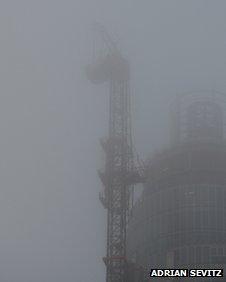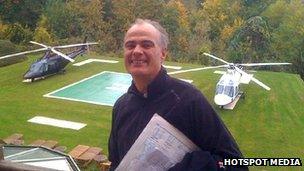Vauxhall helicopter crash 'was preventable'
- Published
Two people died when the Agusta 109 hit a crane
A fatal helicopter crash in central London might have been avoided if safety concerns raised in a 2005 report had been heeded, some experts warn.
In January two people died when the Agusta 109 hit a crane concealed by thick fog and cloud in Vauxhall.
But BBC London has obtained a Civil Aviation Authority (CAA) report into air rules that experts say could have prevented the tragedy.
The CAA says that current rules are in line with international requirements.
The helicopter had left Redhill Aerodrome in Surrey and was waiting to land at Battersea heliport when it struck a crane.
Pilot Pete Barnes, 50, a father-of-two from near Reading, and pedestrian Matthew Wood, 39, of Sutton, south London, were both killed.
The BBC has now seen a relevant study carried out eight years ago with the goal of improving the London CTR, an area of controlled airspace around the capital.
'Impact on safety'
Some 19 experts contributed, from organisations including National Air Traffic Services (NATS), the MoD, the Metropolitan Police Air Support Unit and the British Helicopter Advisory Board.
The report highlighted numerous safety issues relating to bad weather and low-visibility flying.
It concluded: "This review of the London CTR has been an extremely useful activity.

The crane was shrouded with fog on the morning of the crash
"It has highlighted a significant number of issues that need to be addressed in order to resolve issues that may have an impact on flight safety."
However, the CAA has said that no changes were made as a result of the report.
One finding was that the minimum visibility required by helicopter pilots in bad weather may not be great enough.
The report said: "In some cases, the in-flight visibility criteria appeared to be minimal to permit safe separation."
The greater the visibility, the more time an aircraft has to spot and avoid other aircraft - or objects appearing out of fog.
Pete Barnes' client had twice urged him not to fly because of the poor visibility.
Dr Antony Evans, a lecturer in Air Transport at City University London, said several of the proposed changes might have prevented the crash.
He said: "The report specifically pulls out a question on visibility, which is how far ahead the pilot must be able to see.
"The report says this is a cause for concern. That applies specifically to a helicopter operating in these conditions which are exactly the conditions this accident occurred in."
The report also warned of dangers over individual pilots' interpretation of how much visibility they had.
It said: "There could be a problem, and/or an anomaly, with regard to how a pilot actually interprets in-flight visibility, in as much as different pilots may determine similar flight conditions differently."
Dr Evans said: "It becomes a question of perceived visibility - how far do I think I can see? And different pilots have different perceptions.
"So this pilot may very well have thought he was clear of cloud."
The report said that estimates of visibility over central London were mainly based on data from Heathrow.
It said there were "difficulties in basing meteorological criteria on reports from an airport some distance away from the area of operation of the aircraft".
The Air Accidents Investigation Branch (AAIB) preliminary report shows that at the time of the crash, there was about 4km visibility at Heathrow - but just 700m at London City Airport, much closer to the site of the crash.
'Confusing and complex'
A leading helicopter safety consultant, who asked to remain anonymous, said that for the crash to have happened visibility must have been considerably under 1km.
The report also expressed concern about a complexity of rules governing whether aircraft should fly in low visibility.
It said: "There is a plethora of meteorological criteria that contribute to confusing and complex interpretations for flight within the London CTR."

The client of Pete Barnes had twice urged him not to fly because of fog
Dr Evans said: "This is definitely an issue that will relate to the accident.
"The primary recommendation they make is that the meteorological criteria should be simplified. It is a very complex airspace and as the report suggests it needs to be clarified."
The BBC spoke to two experienced pilots and one helicopter safety consultant, all of whom were unaware the 1km visibility rule applied in certain scenarios.
A CAA spokesman said: "An upcoming change in airspace classification will lead to some rationalisation of the criteria.
"Forthcoming alignment with European rules could involve changes to the system and this may also include a reduction in the number of different visibility requirements for aircraft operating in London.
"Helicopter flights in London are strictly controlled with regulations in place to ensure aircraft operate safely."
He went on: "Pilots are required by law to be fully aware of the different rules and requirements that apply to the airspace they are operating in, and must adhere to them at all times.
'Helicopters remain safe'
"Complying with these requirements is a condition of their licence.
"These regulations are in place to ensure helicopter operations in London remain safe. The Vauxhall incident was the first fatal helicopter accident in London since records began in 1976."
The CAA said it could not comment on the crash while the AAIB inquiry continued.
A Department for Transport spokesman said: "The AAIB is carrying out an investigation to determine the circumstances and causes of the accident, taking account of a range of evidence and information.
"It will make recommendations accordingly, and it would be inappropriate for us to speculate before the AAIB's final report is released."

- Published9 February 2013
- Published22 January 2013